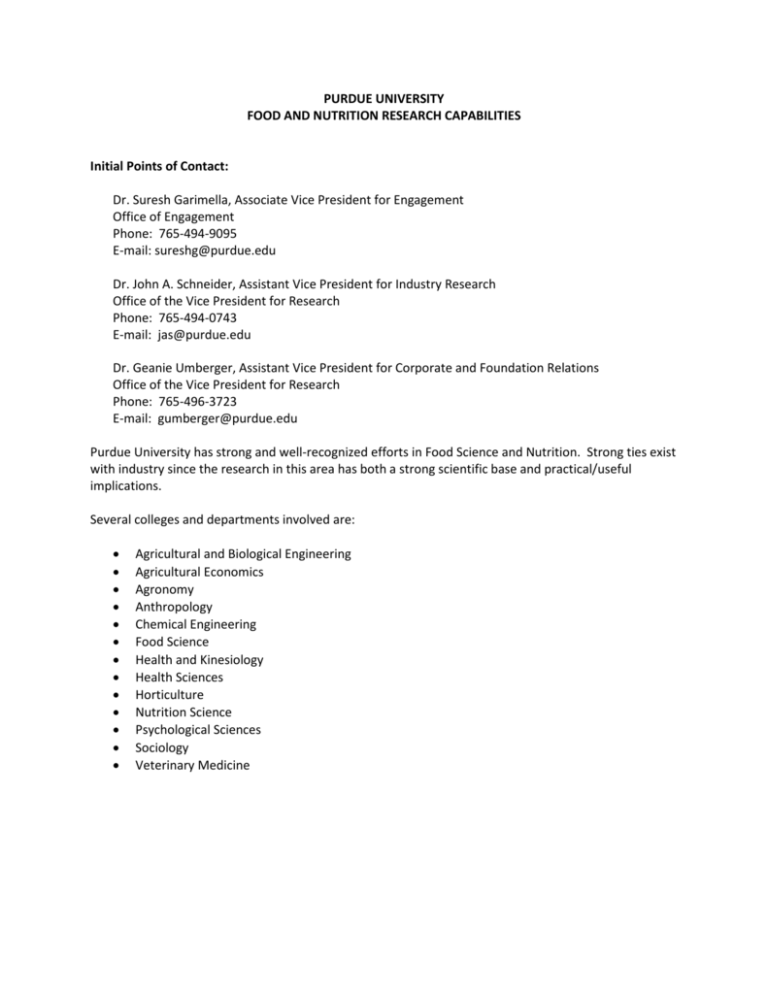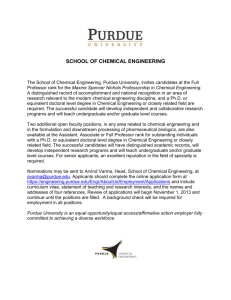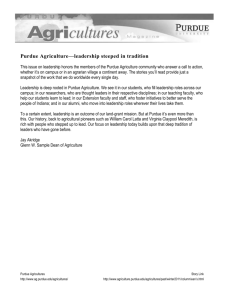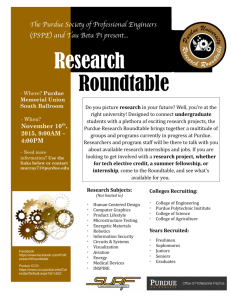PURDUE UNIVERSITY FOOD AND NUTRITION RESEARCH
advertisement

PURDUE UNIVERSITY FOOD AND NUTRITION RESEARCH CAPABILITIES Initial Points of Contact: Dr. Suresh Garimella, Associate Vice President for Engagement Office of Engagement Phone: 765-494-9095 E-mail: sureshg@purdue.edu Dr. John A. Schneider, Assistant Vice President for Industry Research Office of the Vice President for Research Phone: 765-494-0743 E-mail: jas@purdue.edu Dr. Geanie Umberger, Assistant Vice President for Corporate and Foundation Relations Office of the Vice President for Research Phone: 765-496-3723 E-mail: gumberger@purdue.edu Purdue University has strong and well-recognized efforts in Food Science and Nutrition. Strong ties exist with industry since the research in this area has both a strong scientific base and practical/useful implications. Several colleges and departments involved are: • • • • • • • • • • • • • Agricultural and Biological Engineering Agricultural Economics Agronomy Anthropology Chemical Engineering Food Science Health and Kinesiology Health Sciences Horticulture Nutrition Science Psychological Sciences Sociology Veterinary Medicine The major efforts are found in the Department of Food Science (College of Agriculture) and the Department of Nutrition Science (College of Health and Human Sciences). ● Department of Food Science Dr. Suzanne Nielsen, Head (nielsens@purdue.edu) There are four signature areas of research: − Food Chemistry, Structure, and Function Dr. Rengaswami Chandrasekaran Dr. Bruce R. Hamaker Dr. Srinivas Janaswamy Dr. Owen Jones Dr. Andrea Liceaga Dr. Lisa J. Mauer - Lab Website Dr. S. Suzanne Nielsen Dr. Brad . Reuhs Dr. Yuan Yao − Foods for Health Dr. Mario G. Ferruzzi Dr. Bruce R. Hamaker Dr. Kee-Hong Kim − Food Safety and Microbiology Dr. Bruce M. Applegate Dr. Arun K. Bhunia - Lab Website Dr. Haley F. Oliver − Food Processing and Technology Development Dr. Christian E. Butzke - Lab Website Dr. Li-Fu Chen Dr. Carlos M. Corvalan Dr. Kevin M. Keener Dr. Lisa J. Mauer - Lab Website Dr. Mark T. Morgan Dr. Fernanda San Martin Centers Center for Food Safety Engineering (CFSE) –CFSE incorporates a large collection of microbiologists in a food science department with other Purdue University areas for the purpose of rapid detection and eradication of foodborne pathogens. The web site is http://www.cfse.purdue.edu. Whistler Center for Carbohydrate Research (WCCR) – This world renowned center is a universityindustry research center that conducts fundamental research related to practical applications of carbohydrates. The WCCR includes faculty from several departments at Purdue. It has a consortium of companies that interact on a research level. Participating companies receive a research investment value of 80 to 1. The Center is named in honor of Roy L. Whistler. The web address is http://www.whistlercenter.purdue.edu. Center for Integrated Food Manufacturing (CIFM) - CIFM has the mission to raise the level of education in automation and process control among food scientists and engineers, and to increase the value of automation to food manufacturers through enhanced productivity, food quality and food safety. This center includes our departments EHEDG testing and approval facilities. The web site is http://www.ag.purdue.edu/foodsci/cifm/. Food Processing Environmental Assistance Center (FPEAC) - FPEAC is committed to developing and promoting innovative strategies that achieve better environmental results, reduce costs, and promote environmental stewardship throughout the Food Processing Industry. The goal of the Center is to become a primary provider of environmental information, resources, and training to assist small and medium sized food processors in achieving environmental compliance and stewardship. The website is http://www.fpeac.org/. International Food Technology Center (IFTC) - IFTC is a food processing-based center designed to link farmers to markets. The Center, housed at Purdue University’s Department of Food Science, is geared to meet the increasing demand for food and economic growth in agriculturally-based developing economies. The Center is based on recognized research and analytical expertise in food production, processing, and marketing, already in place at Purdue. It also involves efforts within and across universities, national and international research centers, private organizations, and industrial food and equipment companies as they relate to advancing food security by enhancing markets for new and traditionally processed (i.e., value-added) foods and reducing food losses. The website is http://www.ag.purdue.edu/foodsci/foodtechcenter. Facilities Purdue Food Science utilizes state-of-the-art technology to conduct research, teaching, and assisting companies from around the world. The Nelson Hall of Food Science, completed in 1998, has the largest research capacity of any academic building of its kind in the U.S. Its 36 research labs house research in food science as well as food process engineering. Purdue, long known for its efficient utilization of classroom space, adds two more - plus a teaching lab - in the building. Within this building, we utilize the latest technologies to conduct research. We have: a Varian 300 MHz NMR, a Unity Scientific 2500 NIR, a Nicolet Nexus 670 FT-IR with Continuum IR Microscope, an atomic force microscope, a VTI Gravimetric Moisture Sorption Balance, and a steam-injection unit with a flash cooler that reintroduces flavor compounds. The cornerstone of the new building is a state-of-the-art Pilot Laboratory. Operating as a model manufacturing area, it allows manufacturers to see how a process works before committing to full production. Similarly, a key strength of the Department and the new building, the Sensory Laboratory provides sensory analysis through subjective tasting of food acceptability. Industry Relations The Department of Food Science was built around the idea that we have two customers; students, and the industry they serve. We have personnel on staff specifically to assist companies. Laurie Swift, Administrative Director, is available to answer your questions and ensure a "winwin" relationship with the department. For the company that is interested in collaborating with the Department at "a higher level", they have our Industrial Associates, a 20+ year program that helps them improve their program by staying in touch with our industry partners. ● Department of Nutrition Science Connie Weaver, Head (weavercm@purdue.edu) The Department of Nutrition Science is recognized nationally for its vital research contributions to disease prevention and health promotion as well as its outstanding academic programs. We are a rapidly growing department with special strengths in these signature areas: − Calcium, Vitamin D, and Bone Health The Department of Nutrition Science has had a strong presence in calcium nutrition since the mid 1980s. Additional hires have expanded the expertise to include vitamin D and relationships to health that extend beyond bone to cancer, hypertension, body fat, and diabetes. Currently, topics related to calcium and Vitamin D are two of the most funded nutrition areas because of their broad relationship to health and the prevalence of deficiencies in the U.S. and around the world. Contributors in the Department James Fleet Dennis Savaiano Dorothy Teegarden Connie Weaver Engagement The breadth and depth of bone health research being conducted in the Department of Nutrition Science is well documented. Critical to nutrition and health research, such as the bone health work, is dissemination of the research results and concepts to targeted public audiences. Currently, research is being conducted to test tailored educational intervention to improve the bone health of adolescents. If the hypothesis is correct — that the intervention does improve bone health — the educational materials must be made available as widely as possible to the target adolescent audience. For all bone health research findings, Purdue Extension provides a unique national dissemination network for educational programming through Consumer and Family Sciences and 4H/Youth development county-based educators. Other national dissemination groups will be utilized, for example: YWCA, Girl Scouts, and public school teachers for use in their classrooms. Measurement of knowledge, attitude and behavior intent will be made to determine the effectiveness of the educational curriculum. − Botanicals and Bioactives for Health Purdue University has a distinguished reputation in nutrition and pharmacognosy research that dates back many generations. With the advent of the Dietary Supplement Health and Education Act of 1994, the use of botanicals has greatly increased, in some cases, without sufficient concern for safety of intake of various types. The Botanicals Center for Age Related Diseases, led by Purdue in collaboration with the University of Alabama-Birmingham, is one of six centers funded by the National Institutes of Health, Office of Dietary Supplements Core Center Projects (NCCAM) in the US. Contributors in the department John Burgess Wayne Campbell James Daniel James Fleet Elsa Janle Charles Santerre Connie Weaver, Director Engagement The engagement portion of the NIH Botanicals Center for Age Related Diseases has been working collaboratively in support of the research projects and other activities and in developing educational programs for professionals. The engagement program has focused on developing Web sites and Internet-based programs on botanicals: NUANPP Online Botanicals Research Center for Age Related Diseases X-Train − Appetite, Metabolism, and Obesity More than 60 percent of the population is overweight and 25 percent are clinically obese. Over $35 billion is spent annually on diet foods, aids, and programs. The health care costs associated with overweight/obesity are estimated at over $100 billion annually due to the contribution of excess body fat to chronic diseases such as diabetes, hypertension, and osteoarthritis. There are approximately 280,000 preventable deaths from obesity annually, and the toll on productivity and quality of life are high. Dietary approaches to prevent and manage body weight have been largely unsuccessful, in large part because they have failed to address issues associated with hunger and satiety that compromise diet compliance. The importance of exercise in weight management and health optimization has only recently gained attention and remains poorly characterized. The most critical deficiency in knowledge and practice is how appetite and exercise interact to influence food choice, metabolism, and energy balance. Researchers in the Department of Nutrition Science, in collaboration with colleagues on campus and at other institutions, conduct cutting-edge research in this area and support the training of preeminent researchers and practitioners to meet the health care needs of the community, state, and region. Contributors in the Department Kim Buhman Wayne Campbell Rachel Clark James Daniel James Fleet Richard Mattes Barbara Mayfield Megan McCrory Steven McKenzie Dorothy Teegarden Engagement Studies in these areas are facilitated through our teaching and training of undergraduate and graduate students. The nutrition, fitness, and health major is the second largest major in our department (dietetics in the largest) and includes didactic and experiential training provided by numerous faculty including, Rachel Clark, MS, RD, director of the nutrition, fitness and health major, and Steve McKenzie, M Ed, continuing lecturer in exercise and health promotion. Findings from our discovery efforts can be effectively disseminated by one of the strongest teams of Extension educators in the nation. Engagement activities related to the Diet, Energy Balance, and Fitness signature area include the use of the A. H. Ismail Fitness and Nutrition Research and Education Center to conduct nutrition consultations, fitness assessments, and exercise programs to benefit both students and community members. The Ismail Center is a 700+ member facility with which the Department of Nutrition Science works synergistically. Outreach to the community is involved with the clinical experiences as well. PRIDE, the Purdue Resource for Integrative Dietetics and Exercise, is an endowed resource that provides a platform to support the training of preeminent researchers and practitioners to meet the healthcare needs of the community, state, and region. Currently in the developmental stages, the PRIDE Community Education and Outreach Program will actively seek to provide the greater Lafayette and Indiana community with high-quality exercise, appetite, and diet information through health and fitness newsletters, newspaper articles, a nutrition hotline, radio segments, and/or a speakers bureau. SpringFest at Purdue is an opportunity to showcase the department's Signature Areas to children and their parents. Nutrition Science students volunteer their time to run the kids' activity stations, including the milk bottle ring toss and milk mustache pictures, as well as the body fat estimation station for the parents. Several of the learning activities, such as FN 41500: Practicum in Nutrition, Fitness and Health and HPER 42200: Clinical Experiences in Health and Fitness also involve engagement activities with the community residents as 'clients.' − Cancer Prevention It is increasingly clear that states of abnormal cell growth and death regulation are found in a wide variety of disease states including cancer. The impact on mortality of these diseases is clear as cancer is the second leading cause of death in the United States (American Cancer Society). Since 1990, over 12 million cases of cancer have been diagnosed with associated medical costs estimated at $107 billion/year. Any substantive progress in research in these areas will aid in designing preventive strategies and improve the quality of life for those suffering from these diseases as well as reduce the associated health care costs. Understanding the role of nutrients in regulation of cell growth and death decisions will clearly aid in designing recommendations to prevent specific diseases. It has been suggested that nutrients play a prominent role in cancer prevention, but how they regulate cellular growth, differentiation and death is still unclear. For example, colorectal cancer is one of the most common forms of cancer diagnosed each year in the US and as many as 35% of those diagnosed die of this disease. Although many of these cases are the result of an inherited propensity to develop tumors, a majority of the risk is a result of “environmental” causes. Cancer prevention research in the Department of Nutrition Science has been ongoing from many years, however recently the strength of this area has grown. The number of faculty involved in cancer related projects has increased, and the research direction of a new faculty hire in to the Department will be cancer prevention. In addition, the overall environment at Purdue is conducive to enhancing Cancer Prevention as a signature area, with other INP faculty and the unique Purdue Cancer Center. The impression of our department is that only 1 or 2 nutrition departments as a whole are known nationally for their research in cancer prevention. Therefore, there is a gap that Purdue’s Nutrition Science Department is poised to fill. Contributors in the Department Kim Buhman John Burgess Jim Fleet Dennis Savaiano Silvia Stan Dorothy Teegarden Jon Story Resources Available In addition to the excellent laboratory facilities in the department of Nutrition Science, other campus wide resources and collaborations are available to further foster the research in cancer prevention. An important resource on campus is the Purdue Cancer Center. The Cancer Center is one of just eight NCI-designated basic-research Cancer Centers in the United States. The Center is committed to helping cancer patients by identifying new molecular targets and designing future agents and drugs for effectively detecting and treating cancer. In addition, the Indiana Elks Cancer Research Program was established at Purdue University in 1948. Since then, the Indiana Elks Charities, Inc. has provided continual, generous support to the program. In 2002, cumulative donations reached over $2,370,000. The Purdue Cancer Center uses all donations from the Indiana Elks to directly support cancer research, either through the funding of individual and collaborative research grants or the purchase of critical equipment. The core facilities are available to all researchers campus wide. The Cancer Center's core services include: Analytical Cytology DNA Sequencing Drug Discovery Macromolecular Crystallography Mass Spectrometry Nuclear Magnetic Resonance Transgenic mouse core Centers and Programs • • • • • • • • • Botanicals Center for Age-Related Diseases Camp Calcium Cancer Prevention Internship Program Center on Aging and the Life Course Indiana CTSI Ingestive Behavior Research Center International Breast Cancer and Nutrition Project Oncological Sciences Center Purdue University Center for Cancer Research Research Facilities As a part of dramatic departmental growth, we have increased and improved our research facilities. The department offers excellent facilities for both molecular, cellular, biochemical, and clinical studies. − Clinical Laboratory Resources: Body Composition Laboratory Human Performance and Metabolism Laboratory Human Sensory Laboratory Ismail Fitness Center Metabolic Kitchen − Basic Science Resources: Animal facilities Complete cell culture facilities Equipment for separation of both macro- and micronutrients State-of-the-art molecular biology equipment Transgenic animal facility − Analytical Capabilities: Bodily fluids Body composition/energy expenditure Bone density Cell cycle and cell death Diet composition Ingestive behavior Isotopic tracer techniques Macro- and micronutrients Nutrient status Physical performance Sensory function − Special Instrumentation and Skills: Interactive multimedia Web design Kinetic modeling Protein purification Corporate Affiliates The mission of the Purdue Nutrition Science Corporate Affiliates program is to partner with the Department of Nutrition Science in its mission to improve the well being of individuals and families by expanding the knowledge of food and human nutrition through discovery, learning and engagement. The Corporate Affiliates program fosters a relationship between the department and industry to promote research collaborations, employment opportunities and explore current issues pertaining to nutrition and health. Members of Corporate Affiliates have the opportunity to visit campus twice a year to participate in symposia on topical research issues. Members also take advantage of individually arranged visits on topics relevant to specific corporate needs. From an initial meeting of six members in 1996, membership has grown to nearly 30 affiliates. Some recent symposia topics have been: • Processed Foods for Health • IOM Report on Calcium and Vitamin D DRI's & 2010 Dietary Guidelines • SoFas & Salt/To Eat or Not to Eat for Weight Maintenance/Cancer Prevention • Eating Patterns • When Nutrition Meetings Engineering/Public Policy • Botanicals Research and Health • Understanding Metabolic Regulation Membership Benefits: • Corporate visibility with students and faculty • Source of employable graduates • Pre-prints/publications • Research/education partners • Large public outreach networks (Extension) • Training workshops • Staff development • Academic perspective on emerging issues • Commitment by faculty and administration to address members' needs • Semi-annual symposium on topical issues • Extend your staff Areas of Emphasis: • Nutrition and dietetics • Nutrition education • Nutrition, fitness and health • Nutrition and prevention of chronic disease foods • Food chemistry • Chemosensory evaluation • Food safety education Membership Fee Corporate Affiliates pay a minimum of $6,000 per year as an unrestricted gift.







